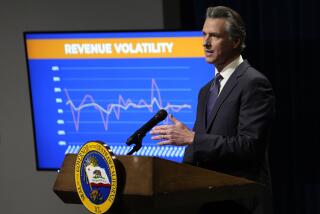Trust States to Take Care of Their Children
- Share via
Liberals tend to believe that social programs thrive in federal hands. Shifting responsibility to the states, they assume, will produce a “race to the bottom” as states try to attract business and keep taxes down by cutting expenditures and regulations. But in education, the experience of the last quarter of a century has been quite the opposite.
Since 1970, the race in public education has been to the top. With California the stark and sole exception, all states have dramatically increased what they spend on their schools. What is even more surprising, historically low-spending states have played catch-up, increasing their expenditures even more than the average.
It’s difficult to make such comparisons. A dollar bought more in 1970 than it did in 1995, and it buys more in Mississippi than in New York. In addition, schools with children from more disadvantaged homes have to spend more to provide the same quality of education that better-off children enjoy. But dollar outlays can be indexed to account for these differences, and the result is a striking picture of real spending on education.
For the nation as a whole, real spending per pupil grew by 41% between 1970 and 1995. And in the lowest spending regions, the Southeast and Southwest, real spending jumped by 71% and 58%, so it is closer to the national average than it used to be, even though the average itself is higher.
It might be supposed that school spending is a special case because public education benefits the middle class--compared, for example, to welfare, which helps only the poor. Perhaps state governments are willing to spend more money on the education of middle-class constituents’ children, but still race to the bottom where the interests of politically less powerful groups are concerned.
Yet much of the new state investment in public education has been for compensatory education for minorities and the poor and special education for the handicapped, programs that do not especially concern most middle-class voters. In fact, nearly two-thirds of the states now supplement federal funds for low-achieving students from poor families, even though they are not required to.
Can the same concern be mobilized in other social policy areas?
One early impetus for the burst in school spending was a raft of litigation about the inequality of spending between districts within a state. In most states, school districts had relied heavily for funds on local property taxes, so the money available to any district depended on the property wealth within its boundaries.
This system began to change in 1971 when the California Supreme Court, in Serrano vs. Priest, found that property tax-based school finance violated the state Constitution. Similar decisions followed in 14 other states. And beginning with a New Jersey decision in 1973, state constitutions have been interpreted to require that all districts receive sufficient resources for an “adequate” education. Constitutional equality is coming to mean that the state is required to spend more on low-income students than it spends on the average student.
Of the states that boosted school funding the most, some acted after court decisions found their property tax financing unconstitutional, but as many acted without any court decision. In Michigan, Maine and Georgia, even decisions to uphold the existing schemes did not dissuade leaders from reforming them.
In California, of course, the Serrano decision was followed by a tax revolt. And school spending took an entirely different course, some say because of conservative control of the Capitol during a period of soaring immigration. But perhaps California’s exceptionalism will be temporary. The Republican establishments in New York and Texas have reacted with much less stinginess to the new immigration wave. And this year, with the recession finally over, California began a big new investment program in education, using an unexpected budget surplus to fund a reduction of class sizes in grades K-3.
Elsewhere, as both liberal and conservative think tanks have focused almost entirely on the federal government, state education policy has developed with little ideological coherence but great political creativity. And nothing resembling a race to the bottom has taken hold. Maybe there is a lesson in this.






